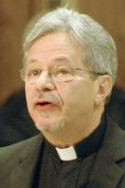Last Updated on October 5, 2012 by Editor
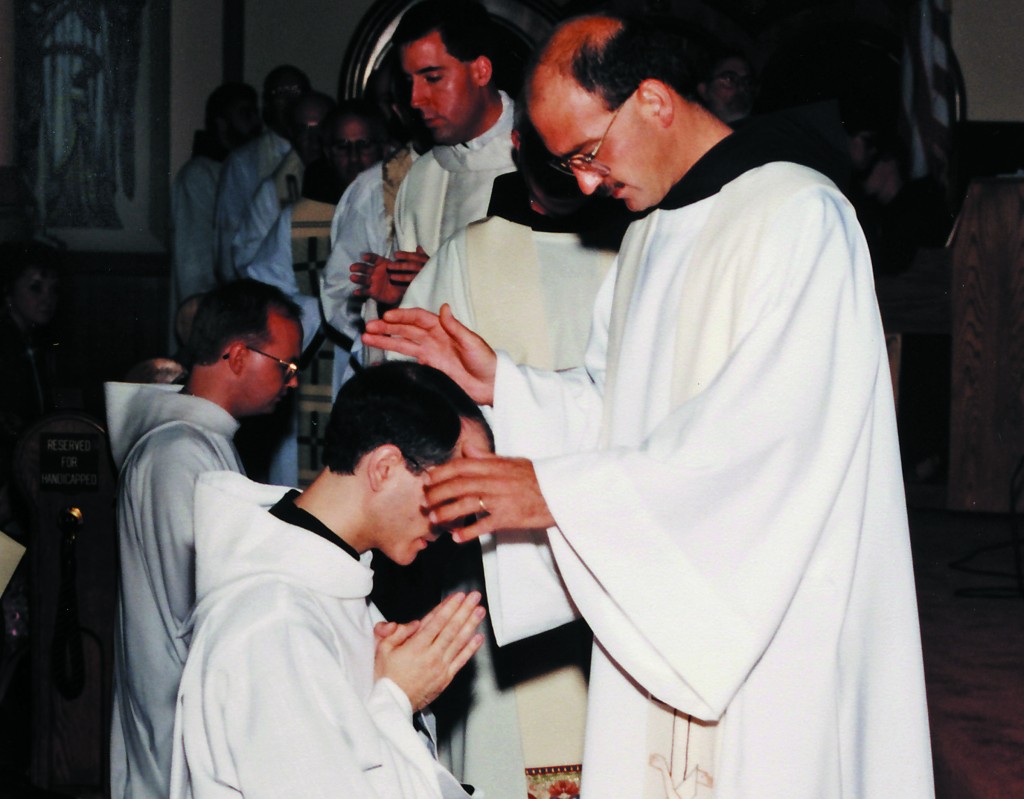
By FRAN PERRITANO
Father William Pizzoglio. Father Joseph Berton. Father Joseph Moffo. Father Ludwig. Father Ralph DiOrio. Father Peter Bortolazzo. Father John Corraro. Father Carmen Negro. Father Henry Benin. Father Joseph Salerno. Father John Rose. Father Jim Cesta.
The list is nearly endless of the names of the men in black who have served at St. Mary of Mount Carmel Church in its 116 years of existence.
Many remember when the parish had a least three priests in residence at one time. Prior to Vatican II, parishioners could witness two Masses going on in church at once – one on the main altar and another on one of the side altars.
But, as we all know, that’s not the case anymore. Many parishes only have one priest. Others have to share clergy. The number of men entering the priesthood has declined precipitously over the decades.
Just check out the numbers in the Diocese of Syracuse alone.
In 1979, there were 401 priests in the diocese – 171 of them younger than 45 and 192 between the ages of 45 and 69. Contrast that with 2011: There were 240 priests in the diocese, and only 140 of them were active. Just 14 were younger than 45, and there were only 91 between the ages of 45 and 69.
The projections for the future are more grim.
The diocese predicts only 14 men will be ordained through 2018. It projects that by 2020, there will be 81 active priests.
What draws men to the priesthood? What are the positives and negatives? Is there anything that can be done about the downward spiral?
Five priests with close connections to Mount Carmel / Blessed Sacrament share their views. Current pastor Father Jim and former pastors Father John Rose and Father Joseph Salerno offer their insights. Also, two priests who have very close ties to the parish also express their thoughts: Father Carmen Malacari and Father Tom Servatius.
Here’s what they have to say:
Father Jim Cesta
Age: Middle age.
Degrees: Master of Divinity; BA liberal arts degrees in literature, psychology, language, liturgy.
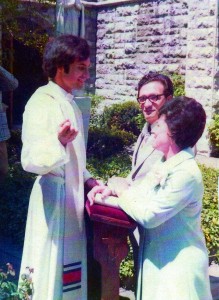
Date of ordination: May 18, 1974.
Connection to Mount Carmel / Blessed Sacrament: Current pastor.
If I weren’t a priest I probably would be: An architect.
When did you get the “calling,” or when did you know you wanted to become a priest?
From earliest years I had a desire and attraction to the priesthood since about seventh grade public school.
After you made the commitment, did you ever have any doubts or started second-guessing your choice?
No second thoughts, always headed for the goal.
What’s the best part of being a priest?
To be involved in the life of the people we serve, in times of joy and celebration, and times of loss or set back or sorrow. To teach and preach and apply the Gospel Word to everyday living is a source of challenge and satisfaction.
What’s the toughest part?
To respond to many calls and needs and requests with limited time and dealing with the shortage of priests these days.
The number of priests continues to decline and older priests are serving longer? If you were in charge and could make or change the “rules,” what’s the one thing you would do to increase vocations?
Consider the option of married Catholic clergy for those so inclined in the future.
Father John Rose
Age: I am ageless.
Education: New Hartford High School Class of 1964.
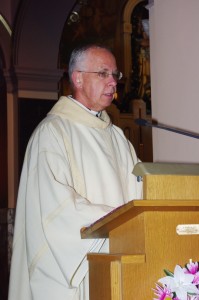
Degrees: Bachelor’s degree in philosophy from Wadham’s Hall Seminary in Ogdensburg, masters in divinity from Christ the King Seminary at St. Bonaventure University, certification in Spiritual Direction from the Center for Religious Development in Cambridge, Mass.
Date of ordination: May 13, 1972.
Current assignment: St Vincent de Paul in Syracuse where we have a strong outreach to the neighborhood, especially to the Sudanese community.
Connection to Mount Carmel / Blessed Sacrament Parish: Former pastor.
If I weren’t a priest I probably would be: I could not imagine myself being anything other than a priest. I feel most fully myself as a priest. I find priesthood very life giving with its many dimensions. I love being the leader of a parish community and helping to grow and strengthen others with a collaborative approach, inviting others to share their gifts in the building of that community and reaching out to those who are in need. I have been blessed with many opportunities and have served as a hospital chaplain, formation director of seminarians, giver of retreats for priests, religious and those in pastoral ministry, and most recently was the director of a spirituality program for priests. I have been strengthened by the faith of so many people who have been role models for me as how to love as Christ did, even in the midst of many personal struggles.
When did you get the “calling,” or when did you know you wanted to become a priest?
From as early as junior high school I felt called to be a priest.
After you made the commitment, did you ever have any doubts or started second-guessing your choice?
Throughout the seminary I wondered if I was worthy to become a priest, but gradually realized that God called me not because I am perfect or the most gifted, but God works through my brokenness and woundedness to cultivate a compassion and acceptance of myself to be a wounded healer for others.
What’s the best part of being a priest?
There are many dimensions of priesthood that I love, especially being with people in times of joy and celebration as well as in times of suffering and pain. I love being able to offer people God’s forgiveness in the Sacrament of Reconciliation and to help process with someone a problem they struggle with. It is a great joy to experience moving from a place of pain to a place of healing. As I have entered my wisdom years I realize that priesthood is less about doing and more about being present to God and others and being a sign of the kingdom of God.
What’s the toughest part?
Having to deal with negative people who are close-minded and have not done their inner work.
The number of priests continues to decline and older priests are serving longer? If you were in charge and could make or change the “rules,” what’s the one thing you would do to increase vocations?
In this age of the shortage of priests, it is a question of making celibacy an option in the diocesan priesthood. There are many potential candidates for the priesthood, some of whom are married, others of whom are women, all of whom feel like they have an authentic call from God.
There is no biblical or theological reason which would prohibit women or married men. Many married Anglican priests have been received into the Roman Catholic priesthood, including those in the new Ordinariate. Should potential candidates wish to live a celibate lifestyle, they have the option of religious life or monastic life.
Father Joseph Salerno
Age: 64.
Education: Roscoe Conkling, Sacred Heart Seminary (high school), Maryknoll College, the University of St. Michael’s College (Toronto)
Degrees: Bachelor’s degree in sociology, master’s degree in divinity.
Current assignments: Pastor of the Church of Our Lady of Lourdes in Utica, regional vicar, fire and police chaplain for the city of Utica.
Connection to Mount Carmel / Blessed Sacrament: Native son and former pastor.
If I weren’t a priest I probably would be: A teacher or a psychologist.
When did you get the “calling,” or when did you know you wanted to become a priest?
The desire was there from the time I was quite young; therefore, I entered and graduated from a high school seminary.
After you made the commitment, did you ever have any doubts or started second-guessing your choice?
Of course I did. Before ordination I took a three-year leave of absence to deal with those doubts. Since ordination, I have never had any doubts about my commitment.
What’s the best part of being a priest?
Being with people at the most joyous and the most difficult moments of their lives.
What’s the toughest part?
The many, varied, and sometimes impossible expectations — from those of the people you serve to those in authority.
Is being a priest all that you thought it would be?
Yes, and more.
The number of priests continues to decline and older priests are serving longer? If you were in charge and could make or change the “rules,” what’s the one thing you would do to increase vocations?
I have been the pastor of two parishes. Each parish has seen someone ordained to the priesthood during my time there. Example and encouragement are key. I would also allow anyone who feels the call to ordained ministry be given the opportunity to pursue the call.
Father Carmen Malacari
Age: 50.
Education: Mount Carmel School, Notre Dame High School, Wadhams-Hall Seminary, St. Hyacinth’s Seminary, Washington Theological Seminary.
Degrees: Bachelor’s in philosophy, bachelors in Franciscan Studies, masters of divinity.
Date of ordination: Oct. 9, 1993.
Current assignment: Pastor of Holy Spirit Catholic Church in Denver, N.C.
Connection to Mount Carmel / Blessed Sacrament Parish: Baptized, First Holy Communion, Confirmation, altar server, decorated church during Christmas, graduated from Mount Carmel School in 1977.
If I weren’t a priest I probably would be: A carpenter
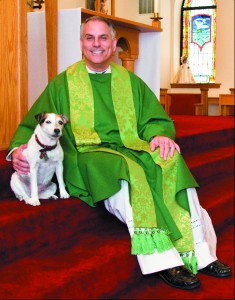
When did you get the “calling,” or when did you know you wanted to become a priest?
My dad would often ask me to consider the possibility of a vocation to the priesthood as a child. I became aware of the possibility of a calling in high school while speaking with my high school religion teacher Father Anthony LaFache, who said that he sensed God calling me to the priesthood.
At first I considered becoming a religious brother, based upon the witness of the Xavierian Brothers at Notre Dame High School. They were very helpful in tutoring me in some of my high school studies. They greatly inspired me because of their care and concern about my education.
I seriously became aware of a call to the priesthood after my second year of college. I was floundering in terms of what direction to go in life. I studied biology in my first year of college at Nazareth College in Rochester in hopes of becoming a biomedical illustrator.
I wasn’t happy with that, and then returned home and attended Mohawk Valley Community College where I tried studying to be an electrical engineer. After not being satisfied with my exposure to that field as well, my dad suggested that I speak to a priest to help me discern what direction my life should take and if there was a possibility of a vocation to the priesthood.
I contacted my religion teacher Father LaFache who was stationed at the time at St. Mary’s on South Street and began to seriously speak to him about the possibility of becoming a priest. After many hours of conversation with him, he drove me to the Chancery in Syracuse where I met with the vocation director, Father Fred Daley at that time.
After meeting with him I began to reflect and pray upon a vocation to the diocesan priesthood. After four months of reflecting and considering the possibility of becoming a priest, I began the formal application process with the diocese of Syracuse.
After you made the commitment, did you ever have any doubts or started second-guessing your choice?
Oh, my gosh, yes. I never envisioned myself as being able to get up in front of people and lead them in the celebration of the Mass or preach, for that fact. I remember having night sweats before becoming ordained wondering how will I do this. However, I sincerely believe that it was the grace of the Sacrament of Ordination that gave me the strength and ability to get up in front of people and lead them in the celebration of the Mass.
I have also found that in times of dealing with personal struggles — self-confidence, administrative responsibilities, inadvertently hurting someone —that I do question and wonder, am I in the right vocation? Has God truly called me to this way of life, or did I somehow misinterpret God’s calling?
What’s the best part of being a priest?
For me, the best part of being a priest is the celebration of the Eucharist and the celebration of the sacraments. When I first sensed God calling me to the priesthood it was the celebration of the sacraments that really appealed to me.
I also feel that when I witness someone spiritually transform from who they once were to who they are now – that brings me the greatest joy. In dealing with a person’s soul you usually can’t see, or always know, if a change takes place – we can only trust that God is at work in them. However, when you are able to visually observe and sense someone’s personal and spiritual transformation, it brings me the greatest source of joy to be an instrument in that person’s life.
What’s the toughest part?
The toughest part of being a priest today is challenging people by preaching the word of God to a society that is becoming increasingly secular, that does not understand the importance of human life from the moment of conception and that is fooled into believing that happiness and fulfillment are found in consumerism.
Secondly, I find that the administrative and financial responsibilities of being a priest and pastor to be very difficult and challenging as well. As a pastor there are so many different responsibilities and tasks that have to run through your fingers almost on a daily basis, which seem to take away at times from the pastoral and spiritual responsibilities of our vocation.
Is being a priest all you thought it would be?
Yes and more. The seminary tried its best to train and prepare us for the church of today, however, there are so many ins and outs and so many other experiences that we encounter on a daily basis that the seminary was never able to prepare us for.
I believe that is why the Lord Jesus gradually revealed his plan of salvation for all of humanity in a gradual manner as well to the apostles. I think that many of them would have been overwhelmed and perhaps would have left His company if they knew what was totally in store for them as followers of Jesus Christ.
The number of priests continues to decline and older priests are serving longer? If you were in charge and could make or change the “rules,” what’s the one thing you would do to increase vocations?
I believe that Vatican II truly paved the way for the challenges that the church would encounter in the future. I believe that we need to revisit many of the important documents such as “Gaudum et Spes” and the “Church in the Modern World” that were issued at the council because many of these documents have yet to be fully realized.
I believe that Pope John Paul II’s document on the “Universal Call to Holiness” needs to be revisited as well. The Lord calls all of us by the virtue of our baptism to step forward and to utilize the gifts and talents that we all have been blessed with and put them at the service of the church and of our brothers and sisters.
If the baptized understand that each of them is called to step forward and minister and serve in the church, then many of the ministries that priests and religious once assumed perhaps can be done by them.
Perhaps the Holy Spirit is moving us in a new and different direction and asking us priests and religious to step aside and make room for the people of God to step forward and help build up the Body of Christ.
Since John Paul II placed in the “Deposit of Faith” that women cannot be ordained to the priesthood, since the church does not have this tradition I don’t think that this will ever change. The church has and continues to have a special place in its church for women and the valuable ministry that they provide to the Body of Christ.
Perhaps with the influx of former Anglican married priests, who have entered into full communion with us, may be one way of helping to address the decrease in vocations to the priesthood.
Father Tom Servatius
Age: 52.
Education: St. Joseph-St. Patrick grammar school, John F. Kennedy High School, Mohawk Valley Community College, LeMoyne College, Syracuse University, St. Mary’s Seminary and University in Baltimore.
Degrees: Associate degree in general studies, bachelors in business administration, masters in social work, masters in divinity.
Date of ordination: June 7, 2003.
Current assignment: Pastor of St. Augustine’s Parish, Baldwinsville, and director of Seminarian Formation for the Syracuse diocese.
Connection to Mount Carmel / Blessed Sacrament Parish: I’m an adopted son of the parish.
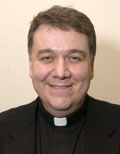 If I weren’t a priest I probably would be: Landscaping, preferably urban landscaping. Green spaces. Community gardens. Big indoor atriums.
If I weren’t a priest I probably would be: Landscaping, preferably urban landscaping. Green spaces. Community gardens. Big indoor atriums.
When did you get the “calling,” or when did you know you wanted to become a priest?
Started thinking about it at 9, and has been on the back of my mind since. I almost applied at 19, and again at 26, but finally took the plunge at 37.
In my mind, it was more of a question of when, not if. And one night in Friendly’s on Burrstone Road, Father Joe Salerno threatened me. He said that if I didn’t go to seminary, he was going to make me the festival chairman! Knowing how heavy then-chairman Mario LaPolla’s briefcase was back then, it was a no-brainer.
After you made the commitment, did you ever have any doubts or started second-guessing your choice?
One of the crossroads I had to discern was whether I was called to diocesan or religious life. Sometimes I second-guess my choice of diocesan priesthood. Many times I wonder if it would be easier to navigate these times in the church if I was in a religious order. And I wonder if I would have more time to garden in a religious order. Of course, you know what they say about the grass being greener on the other side. (What do I say about the grass being greener on the other side? Check for a leaky septic tank.)
What’s the best part of being a priest?
I cannot remember the last day I had when I DIDN’T laugh. The best part has gotta be the people. Seeing God’s presence among them. They’re awesome.
What’s the toughest part?
1) Striking a balance between competing demands. 2) Navigating the waters of conflicting expectations. 3) And dealing with polarization — the mindset which would say, “Since you don’t think like I do, you’re clearly wrong.” That really gets under my skin. And no one (lay, religious, ordained, liberal, conservative, progressive, traditional, Democrat, Republican) seems to hold a monopoly on this mindset. It is frighteningly rampant.
Is being a priest all you thought it would be?
Is one’s life ever what one thinks it would be? For me, before I even went to seminary I knew it was going to be a crazy ride. Some days, the reality of crazy is pretty painful. Most days, however, the reality of crazy is pretty incredible.
The number of priests continues to decline and older priests are serving longer? If you were in charge and could make or change the “rules,” what’s the one thing you would do to increase vocations?
Since there is a greater chance of my becoming an urban landscaper than there is of my becoming the “one in charge,” I’m not gonna go there. Besides, the Spirit is in charge. Let’s let it go at that.
You’re director of seminary formation. Tell me something about this job.
This is the other half of my “job.” It is my responsibility to screen applicants for the seminary and facilitate a recommendation to the bishop about the applicants.
For several years (long before the abuse crisis), Syracuse has had a reputation for conducting some pretty rigorous screening procedures, and I thank my predecessors in the position for their wisdom is setting it up this way.
It also is my job to journey with them during the formation years. Currently, the diocese has 13 seminarians, ranging in formation stage from junior year in college to fourth year of major theology. It can take anywhere from five to nine years to complete formation, depending on their academic and formational experiences.
We send them to either Washington, Baltimore or New York. They’re good guys. Sure, they drive me crazy sometimes, but they’re worth it. And if I were to be rolled into an ER today, I’d be at peace with any one of them standing over me.
